If you haven’t already started, now’s the time to plan your 2019 training program. One that supports your individual needs and goals. So you can feel good, perform at your best, and be competitive.
A big part of that plan should be choosing exercises that will give you the biggest bang for your buck.
Too often I see athletes doing exercises that are falling well short of their intended outcome. And in many ways are harming their body and performance.
It pains me to see athletes wasting time, energy, and resources.
And I don’t want to see you be one of them. Because any opportunity to improve is precious and time-sensitive as you age.
To make sure that you don’t become an unwanted statistic of lost potential, I have a few points to share.
Read on to learn the type of exercise that’s relevant to what you want.
As an athlete, your exercise selection will fall under two main categories.
General and Specific
Specific is the exercise you get when you practice or play your sport or activity of choice.
While general is every other exercise that’s supportive to the specific.
In many cases, I see athletes who try to bring specificity into their training. They do this by only attempting exercises that mimic their sport. And hoping that it transfers to their performance.
But that’s not an efficient and effective means to develop your body.
It’s the general exercises that matter most in building strength and power. And have the greatest impact on your sport or activity.
One thing that general exercises are not is “sexy.” But they are effective.
They help you to refine the fundamentals of movement. And that’s what makes up your foundation to athleticism.
General does not mean random.
On Instagram, you’ll see me doing a diverse range of exercises to feed the social media machine. The abundant variety is me trying to be “sexy” with general exercises. Lol.
To be clear, my hope in doing this is that my posts empower you to find new ways to challenge yourself.
But by no means do I encourage you to do add each exercise to your 2019 repertoire. Because that randomness would not produce much in terms of your results. It’s the relevance of the exercise to your goals that will make the difference you want to see and feel.
80/20
Your plan of challenges should be goal-driven. You’ll use general exercises for 80% of your training stimulus. The remaining 20% of your plan should be devoted to prehab and mobility exercises to aid in lowering your risk of injury.
Combined, you can build the durability it takes to be an Athlete For Life.
Below you’ll see the categories of the fundamental movements that help build strength and power. And exercise examples to periodically incorporate throughout your training year.
Hip Dominant (Hinge)
- Deadlift
- Romanian deadlifts (RDL)
- Good mornings
- Reverse hyperextension
Knee Dominant (Squat)
- Front squat
- Back squat
- Split squat
- Bulgarian split squat
Explosive Movements
- Clean
- Snatch
- Push-Press
- Jerk
- Jumps
- Medicine ball throws
Pushing
- Horizontal (i.e. bench press)
- Vertical (i.e. military press)
Pulling
- Horizontal (i.e. bent over rows)
- Vertical (pull-ups)
Variation
There are number of ways that you can vary the exercises listed above to stimulate growth. Once you select those that you’ll focus on to start, then determine the tools you want to use such as:
- Dumbbells
- Kettlebells
- A straight bar
Whichever you choose, narrow the exercise down further. Do this by deciding if your exercise will be bilateral or unilateral. Meaning, will you be using your left and right side at the same time, or one side at-a-time?
Next, decide on your starting, middle, and ending body position such as:
- Sitting
- Hanging
- Hinging
- Squatting
- Kneeling or half kneeling
- Lying down (incline, horizontal, or decline)Standing (parallel, split, or single leg stance)
Then determine what plane of movement (sagittal / frontal / transverse) you want to emphasize. Sports place a multi-planar demand on your body. So it’s important to approach them all.
Last but not least, define the tempo that dictates the speed of each phase of the exercise movement. For example for jumping, you want to be explosive on the up movement. Then you can come down slow to show controlled stability. Or you can come down fast to add more of an elastic effect for the next rep. To learn more about exercise tempo, you check out my article here.
Making time to organize the exercise selection in your plan will help you get massive results in 2019.
Okay. That’s all for now. So start now while it’s fresh on your mind.
And as always, stay athletic.
Your coach,
Adam

